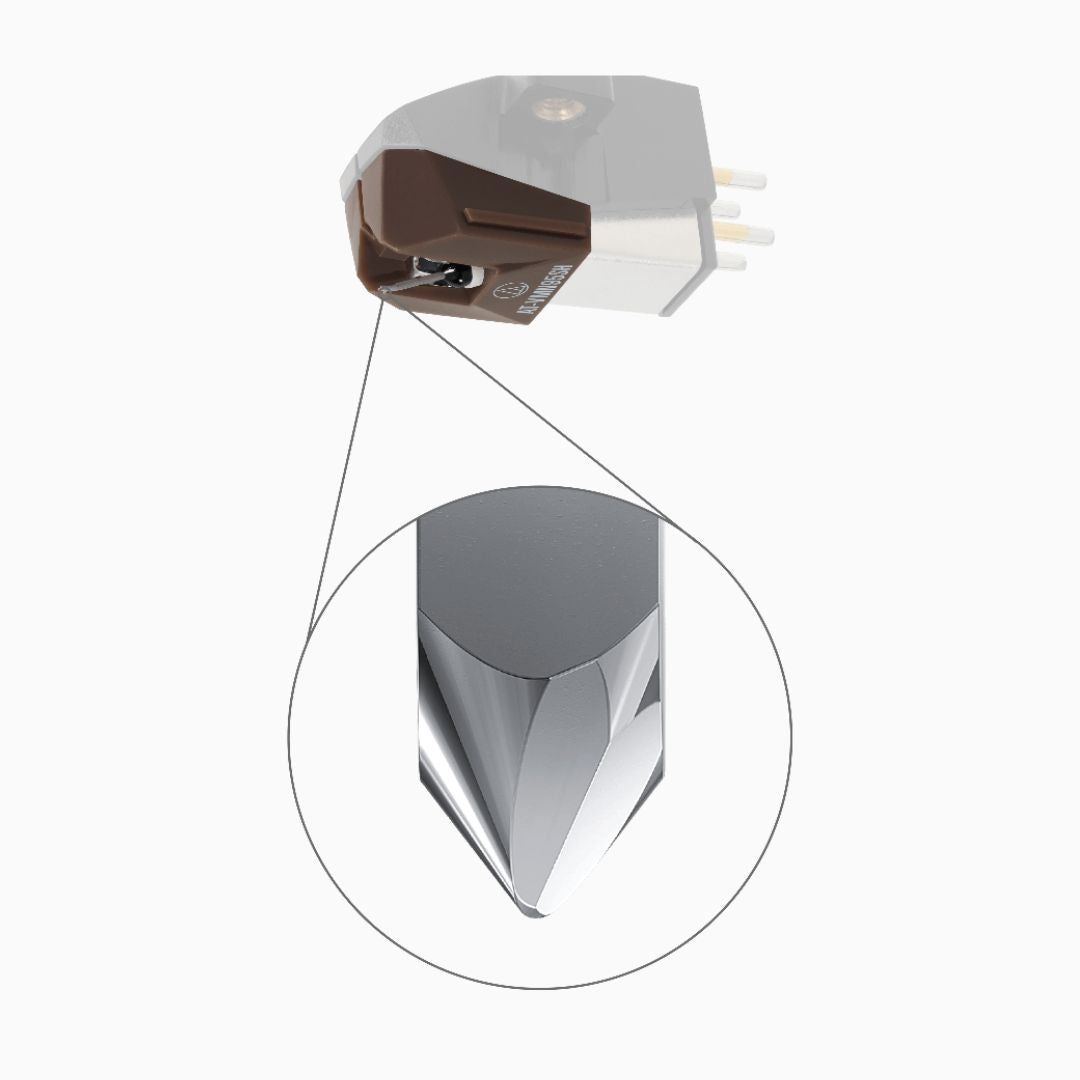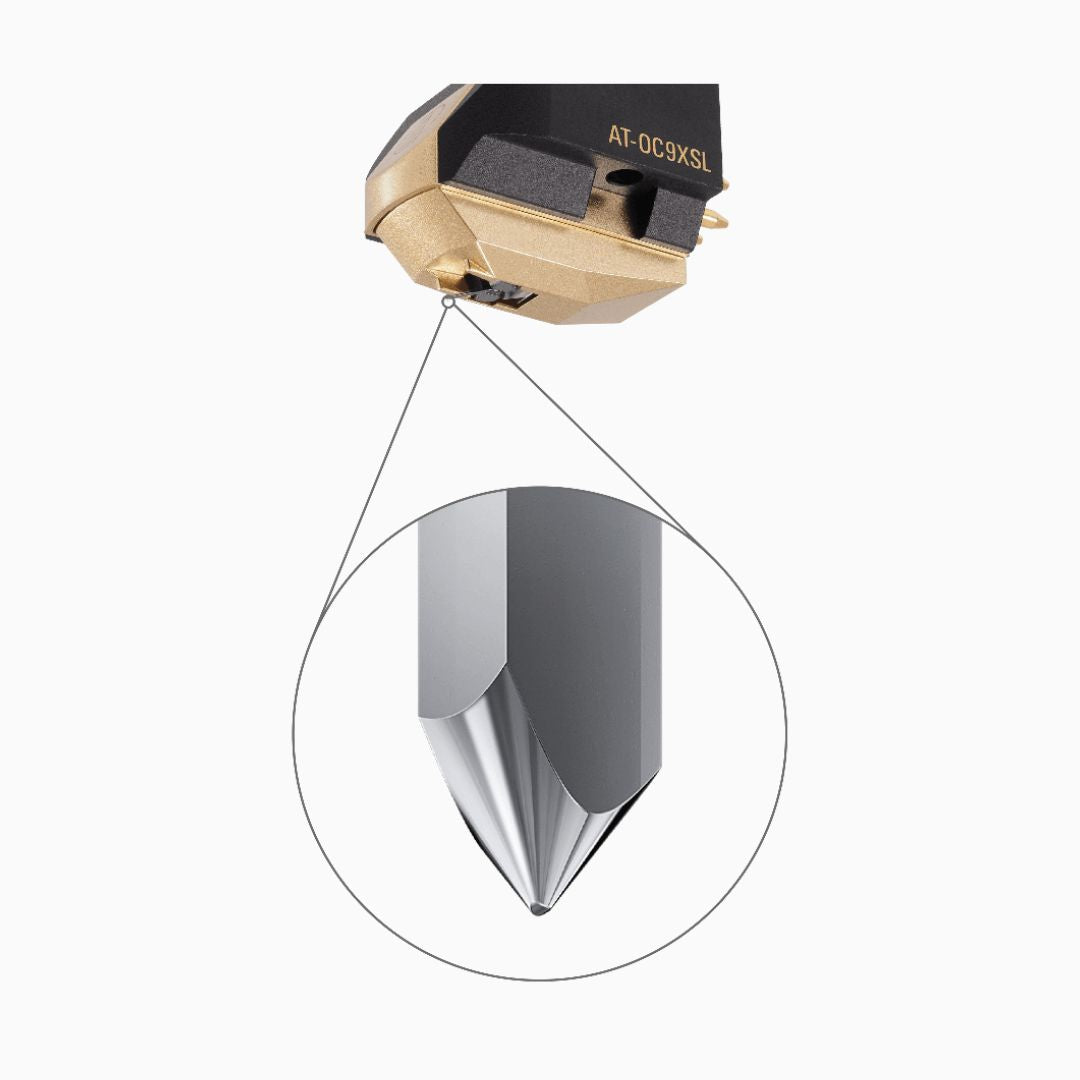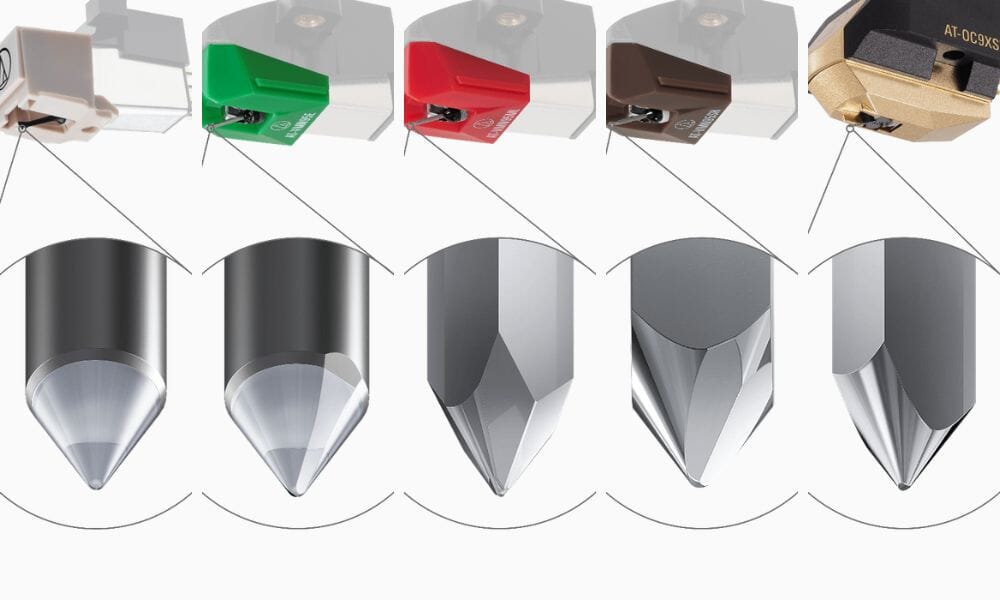A turntable stylus, also known as a needle, comes in various types and designs, each suited for different applications, budgets and preferences.
There are five main types of turntable stylus:
- Conical Stylus
- Elliptical Stylus
- Microlinear Stylus
- Shibata Stylus
- Line Contact Stylus
In this guide we'll cover the five main types of record player stylus, we'll look at how they compare, which one is best for you and how long they typically last.
The Main Types Of Record Player Needle
Conical Stylus (Most Common)
This is the most common and basic stylus shape. It has a rounded tip that contacts the groove walls of the record.
Conical styli are suitable for general-purpose listening and are often found on entry-level turntables.
Elliptical Stylus
An elliptical stylus has a more elongated shape, offering a smaller contact area with the record groove. Elliptical styli provide better tracking ability and are known for delivering improved detail and clarity in the sound.
They are commonly found on mid-range to high-end cartridges and make for a great cost-effective upgrade to your turntable, you can easily improve the sound quality without spending a fortune.
Shibata Stylus
The Shibata stylus has a very narrow, flat contact surface. It is known for its precision and ability to reproduce high-frequency information.
Shibata styli are often used in audiophile-grade cartridges for high-fidelity playback, especially in applications where accurate tracking is crucial.

MicroLinear Stylus
Similar to the Shibata, the Microlinear stylus has a narrow contact surface, allowing for excellent tracking and high-frequency response.
MicroLine styli are found in high-end cartridges, providing detailed and accurate reproduction of the audio signal.
Line Contact Stylus
The line contact stylus has a very fine and extended contact area with the record groove, allowing for precise tracking.
Line contact styli are often employed in top-tier audiophile cartridges for superior tracking and fidelity.
Bonded vs Nude Stylus
"Nude" and "bonded" refer to the construction of the stylus tip, which is the part of the turntable cartridge that makes direct contact with the grooves of a vinyl record.
The terms describe different methods of attaching the diamond or stylus tip to the cantilever (the thin rod that holds the stylus).
It's quite hard to tell from the picture above, but we'll explain it in more detail below.
Bonded Stylus (Most Common)
In a bonded stylus, the diamond tip is attached or bonded to a small metal shank, which is then attached to the cantilever.
The diamond is not directly part of the cantilever.
- Advantages: Bonded styli are often more durable than nude styli because the diamond is not as exposed. They may also be less expensive to manufacture.
- Use: Bonded styli are found in a range of cartridges, from entry-level to mid-range models. They offer a good compromise between performance and cost.
Nude Stylus
A nude stylus is directly attached to the cantilever without any additional support material.
In this design, the diamond tip is essentially an extension of the cantilever.
- Advantages: Nude styli are known for their minimal mass and high precision. The lack of additional material around the diamond allows for improved responsiveness and better tracking of the record grooves.
- Use: Nude styli are commonly found in high-end cartridges designed for audiophile-grade performance.
The choice between a nude and bonded stylus often depends on the desired level of audio quality, budget constraints, and the intended use of the turntable.
Audiophiles who prioritise the highest fidelity may opt for nude styli, while those looking for a good balance between performance and affordability may choose a cartridge with a bonded stylus.
All of the turntables that we sell come with a bonded stylus, the nude stylus are usually reserved for the much more expensive higher-end turntables as they typically cost £100+ just for the stylus.
It's important to note that both types of stylus can provide excellent sound reproduction, and the overall design and quality of the cartridge, as well as the turntable setup, also play crucial roles in determining the audio performance.
How Long Does A Record Player Stylus Last?
The lifespan of a turntable stylus can vary depending on several factors, including the quality of the stylus, the type of materials used, the tracking force applied, and the condition of the records being played.
On average, a stylus can last anywhere from 300 to 1,000+ playing hours.
According to Audio-Technica:
- Around 500 hours for a conical stylus
- 300 hours for an Elliptical stylus
- 1000 hours for a Microlinear stylus
- 800 hours for a Shibata stylus.
There are some factors that can influence the lifespan of a stylus:
-
Stylus Quality: Higher-quality styluses made from durable materials such as diamond or sapphire tend to have a longer lifespan compared to lower-quality alternatives.
-
Tracking Force: Incorrect tracking force can accelerate stylus wear. It's essential to set the tracking force according to the manufacturer's recommendations for your specific cartridge.
-
Record Condition: Playing records that are dirty, dusty, or damaged can contribute to stylus wear. Clean records and proper handling can help extend the lifespan of the stylus.
-
Playing Time: The more you use your record player, the faster the stylus will wear out. Occasional use will naturally result in a longer lifespan.
-
Anti-Skate and Tonearm Alignment: Proper setup of anti-skate and tonearm alignment can reduce unnecessary stress on the stylus and cartridge, contributing to longer life.
It's important to monitor the condition of the stylus regularly.
Signs to look for that a stylus may need replacement include:
- A decrease in sound quality
- Distortion
- Skipping
- Visible wear on the diamond tip.
It's also really important to maintain, clean and look after your stylus, especially if you upgrade to a more expensive one!
Read More: How To Clean Your Turntable Stylus
If you notice any of these signs, it's advisable to replace the stylus promptly to prevent potential damage to your records and the cartridge.
Keep in mind that stylus lifespan estimates are general guidelines, and actual usage patterns can vary.
Following the manufacturer's guidelines for maintenance and replacement, as well as proper turntable setup, will help maximise the lifespan of your stylus.
Conclusion
Hopefully you can now see the difference between the five main types of turntable stylus.
To summarise, there are five main types, listed in order of sound quality/cost; Conical Stylus, Elliptical Stylus, Microlinear Stylus, Shibata Stylus, Line Contact Stylus.
The most common turntable stylus is conical and the easiest/cheapest upgrade you can do is to change to an elliptical stylus.
Credits
Stylus Images: Audio-Technica
We stock most of the Audio-Technica range of replacement stylus here.

